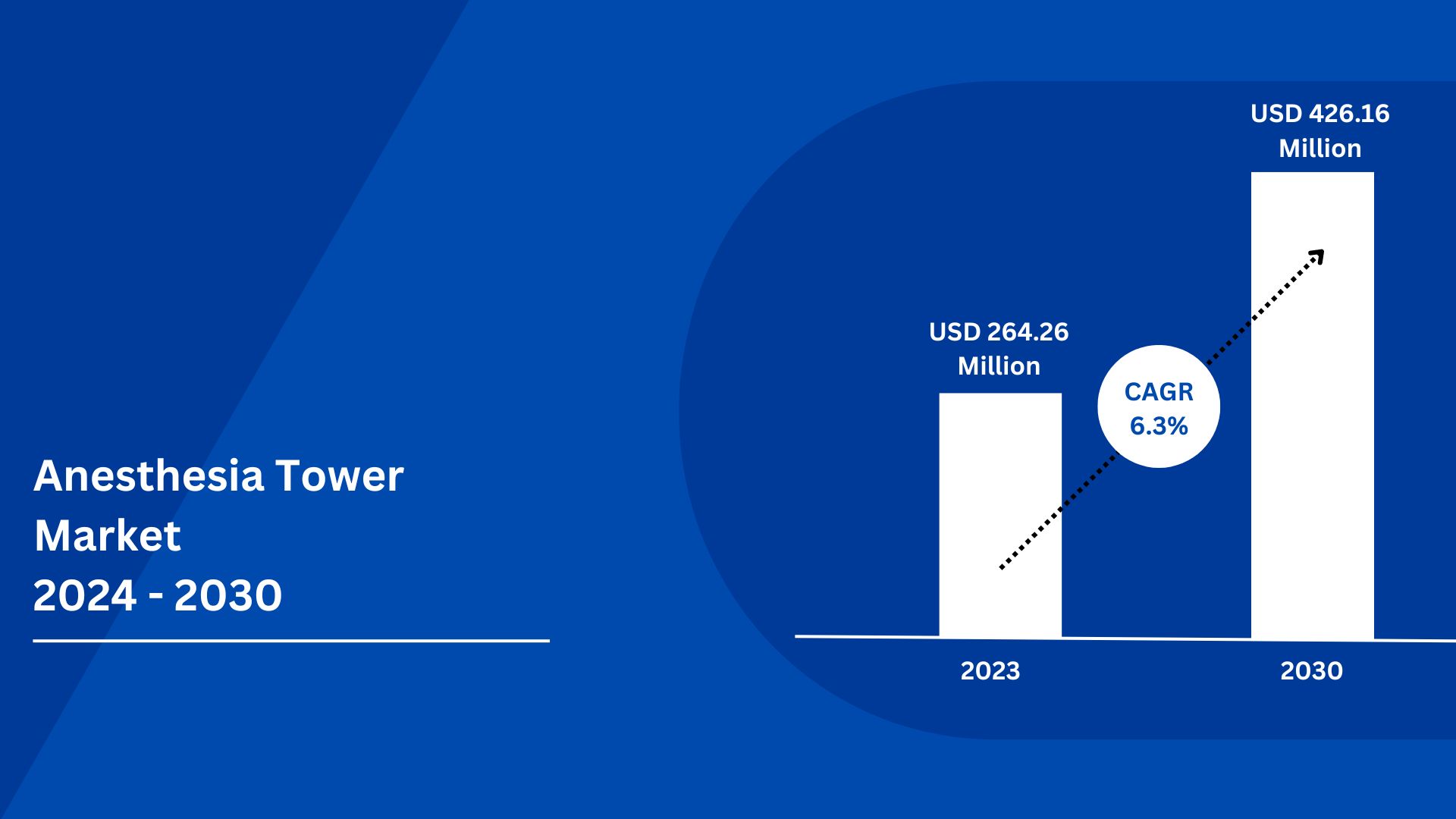TOP CATEGORY: Chemicals & Materials | Life Sciences | Banking & Finance | ICT Media

Download Report PDF Instantly
Report overview
The global Anesthesia Tower market was valued at USD 264.26 million in 2023 and is projected to reach USD 426.16 million by 2030, growing at a Compound Annual Growth Rate (CAGR) of 6.3% during the forecast period (2024-2030). The influence of COVID-19 and the Russia-Ukraine War were considered while estimating market sizes.
An anesthesia tower is a specialized medical equipment setup used in operating rooms to deliver and regulate anesthesia gases and medications to patients during surgical procedures. It typically includes components for gas mixing, vaporization, monitoring of vital signs, and control of anesthesia depth, enhancing safety and efficiency in anesthesia administration.
Demand Drivers: Increasing surgical procedures globally, advancements in anesthesia delivery systems, and the need for efficient healthcare infrastructure are key factors driving the market growth.
Technological Advancements: Anesthesia towers are incorporating advanced features such as integrated monitoring systems, touchscreen interfaces, and automated delivery systems, enhancing safety and efficiency in anesthesia administration.
Hospital Preferences: Hospitals and surgical centers are increasingly adopting anesthesia towers due to their compact design, ability to streamline workflow, and integration of multiple functions in a single unit.
Regional Dynamics: Market growth may vary by region depending on factors such as healthcare infrastructure development, regulatory frameworks, and healthcare expenditure levels.
Market Segmentation: The market may be segmented based on type (manual vs. automated anesthesia towers), end-user (hospitals, ambulatory surgical centers, clinics), and geographic regions to cater to diverse customer needs and preferences.
Competitive Landscape: Companies in the market are likely to focus on product innovation, strategic partnerships, and expanding their distribution networks to gain a competitive edge.
Challenges: Challenges in the market could include high initial costs of anesthesia towers, regulatory compliance requirements, and the need for training healthcare professionals on new technologies.
Future Outlook: With ongoing advancements in medical technology and increasing demand for efficient anesthesia delivery systems, the anesthesia tower market is expected to continue its growth trajectory beyond 2030.

The global key manufacturers of Anesthesia Tower include Kangerjian, Stryker, GCC CLEANTECH, Howell Medical, Chenhong Medical, Huaen Medical, Delang Medical, Yuxin Medical and Adventa Medical, etc. in 2023, the global top five players have a share approximately % in terms of revenue.
The main function of the anesthesia tower is to provide patients with anesthesia gas, which is an indispensable auxiliary equipment for modern clean operating rooms.
This report aims to provide a comprehensive presentation of the global market for Anesthesia Tower, with both quantitative and qualitative analysis, to help readers develop business/growth strategies, assess the market competitive situation, analyze their position in the current marketplace, and make informed business decisions regarding Anesthesia Tower. This report contains market size and forecasts of Anesthesia Tower in global, including the following market information:
MARKET MONITOR GLOBAL, INC (MMG) has surveyed the Anesthesia Tower manufacturers, suppliers, distributors and industry experts on this industry, involving the sales, revenue, demand, price change, product type, recent development and plan, industry trends, drivers, challenges, obstacles, and potential risks.
Total Market by Segment:
Global Anesthesia Tower Market, by Type, 2019-2024, 2025-2030 ($ Millions) & (Units)
Global Anesthesia Tower Market Segment Percentages, by Type, 2023 (%)
Global Anesthesia Tower Market, by Application, 2019-2024, 2025-2030 ($ Millions) & (Units)
Global Anesthesia Tower Market Segment Percentages, by Application, 2023 (%)
Global Anesthesia Tower Market, By Region and Country, 2019-2024, 2025-2030 ($ Millions) & (Units)
Global Anesthesia Tower Market Segment Percentages, By Region and Country, 2023 (%)
Competitor Analysis
The report also provides analysis of leading market participants including:
Further, the report presents profiles of competitors in the market, key players include:
Outline of Major Chapters:
Chapter 1: Introduces the definition of Anesthesia Tower, market overview.
Chapter 2: Global Anesthesia Tower market size in revenue and volume.
Chapter 3: Detailed analysis of Anesthesia Tower manufacturers competitive landscape, price, sales and revenue market share, latest development plan, merger, and acquisition information, etc.
Chapter 4: Provides the analysis of various market segments by type, covering the market size and development potential of each market segment, to help readers find the blue ocean market in different market segments.
Chapter 5: Provides the analysis of various market segments by application, covering the market size and development potential of each market segment, to help readers find the blue ocean market in different downstream markets.
Chapter 6: Sales of Anesthesia Tower in regional level and country level. It provides a quantitative analysis of the market size and development potential of each region and its main countries and introduces the market development, future development prospects, market space of each country in the world.
Chapter 7: Provides profiles of key players, introducing the basic situation of the main companies in the market in detail, including product sales, revenue, price, gross margin, product introduction, recent development, etc.
Chapter 8: Global Anesthesia Tower capacity by region & country.
Chapter 9: Introduces the market dynamics, latest developments of the market, the driving factors and restrictive factors of the market, the challenges and risks faced by manufacturers in the industry, and the analysis of relevant policies in the industry.
Chapter 10: Analysis of industrial chain, including the upstream and downstream of the industry.
Chapter 11: The main points and conclusions of the report.